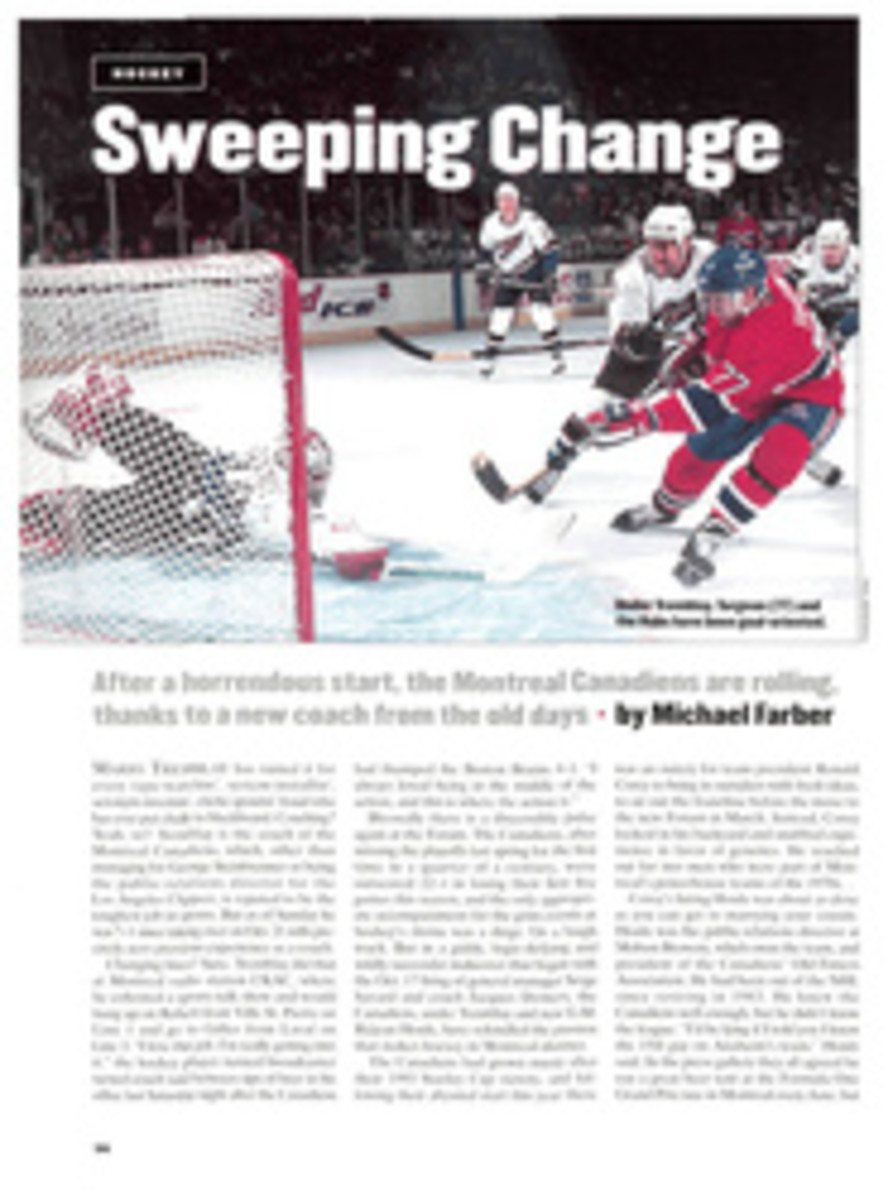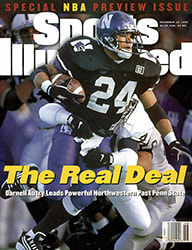
TURKS IN GREASE SINCE 1361 GRAPPLERS HAVE GATHERED AT THE ANNUAL SUPER BOWL OF OIL WRESTLING
There is something primal about wrestling, whether it involves
the naked Beowulf grappling with the bestial Grendel in a misty
swamp or former New York Giant linebacker Lawrence Taylor
straining against pro wrestling bad boy Bam Bam Bigelow for
pay-per-view millions. While pro wrestling in the U.S. amounts
to little more than choreography with muscles, in other parts of
the world wrestling retains its archaic form--and prestige.
Less renowned than the struggles of the gargantuan sumos of
Japan are those of the practitioners of Turkey's yahli guresh,
or greased wrestling. Once a year for the last 634 years,
wrestlers have gathered for Kirkpinar, a three-day tournament
that caps a weeklong festival in June and is essentially the
Super Bowl of greased wrestling. Since the 1800s the festival
has been held in the city of Edirne.
"There are 300 oil-wrestling tournaments that take place all
over Turkey," says Ahmet Yeniji, a referee and former wrestler,
"but none draws so much attention as Kirkpinar."
Edirne, once the capital of the Ottoman Empire, boasts five
centuries of architectural history. The city is in northwestern
Turkey, in Thrace, and the jewel of its skyline is the Selimiye
Mosque, whose minarets rise toward the heavens like great horns.
In honor of Kirkpinar, a net that is nearly invisible by day is
strung between two of the minarets during the tournament. After
dark the net glows with little lights, the words Er Meydani
(Field of Men) floating over the city.
This year more than 700 wrestlers gathered to grapple on the
field. Barefoot and bare-chested, gleaming with oil and wearing
only leather calf-length trousers called kispets, the wrestlers,
or pehlivans, entered the field 50 at a time. The field was
about 100 yards square, the grass uncut. A band whose members
played drums called davuls and clarinets, known as zurnas, set
the tempo as the wrestlers advanced in a wave, lifting their
legs high, slapping their thighs and throwing their arms forward
in a seemingly lighthearted dance called peshrev.
Wrestlers then began to pair off with their opponents, who had
been determined by lottery. Stalking each other like panthers,
they assessed one another's strength in three stylized passes.
On one pass, each man reached down to touch the other's calves;
on another they embraced and rubbed each other's backs; on yet
another they stopped to swing each other's arms to gauge the
opponent's strength.
And then the various pairs came together and the matches began,
often developing into grueling contests that lasted more than an
hour. "Ten years ago began the limiting of time," lamented Kemal
Temizoglu, a fan who said he had been watching Kirkpinar for 39
years. "Before this, some matches lasted two days."
The horde of wrestlers who paraded on the field the first
day--from five-year-old boys to men in their late 30's--was
winnowed so that on the morning of day three only eight were
left in each of the eight divisions, which were determined not
by weight but by age and by success in competition. By evening,
the finals began.
According to legend, Kirkpinar derives from a marathon match
that took place in the 14th century. Returning from a successful
military campaign in the Empire's northwestern region, Suleyman
Pasha and a vanguard of 40 of his best warriors camped in the
town of Samona. To entertain themselves the warriors held a
wrestling tournament. Two of the grapplers struggled for hours,
but no victor emerged. A return match was held some months
later, on May 6, Spring Festival Day. The two wrestled from
morning until midnight on Ahur Koy meadow, again with no winner.
Utterly exhausted, both men died that night, and in the morning
their comrades buried them under a fig tree. When the warriors
returned a year later, some springs had risen between the two
graves, so the place became known as Kirkpinar (Forty Springs).
Unlike in "mat wrestling," as the greased combatants call the
five-minute Olympic-style sport, no points are awarded during
the first hour of a yahli guresh match. The contest ends when 1)
"a wrestler's belly sees the stars," as Temizoglu puts it; 2) a
wrestler is lifted above the shoulders of another and carried
for three steps; or 3) a wrestler pins his opponent or forces
him into a position in which his back is to the ground and he is
on both elbows. If there is no winner after an hour, a 10-minute
tiebreaker follows, in which a point system much like the one
used in international mat competition is applied.
In Edirne some of the wrestlers were lean, others so heavily
muscled that they resembled glazed ceramic statues. Still others
seemed to have followed the George Foreman approach to training.
Because of the way divisions are determined, wrestlers often
faced considerably larger opponents.
With 25 matches going on at once, a spectator could glimpse
something of the frenzy of ancient battle, as one-on-one
struggles took place all over the field. Cheers and shouts often
steered viewers' attention from a stalemate to a match in its
last throes, one man lifting his arms to the crowd while the
other walked off with his head bowed to avert meeting the eyes
of spectators.
The eight divisions in Kirkpinar range from the lowest, ayak
(foot), to bosh (head, or master class). Just as heavyweights
command the biggest purses in professional boxing, the bosh
garners most of the attention and money in Kirkpinar. Winners
earn thousands of dollars or a camel--their choice--and are
often showered with riches and honored with statues in their
hometowns. A three-peat will get you a gold belt. To join the
bosh a wrestler must work his way up through the lower divisions.
This year two men--Ahmet Tascha, 34, and Jengiz Elbiye, 28--were
the focus of the most attention. In a controversial match last
year, Elbiye upset Tascha, the four-year defending Kirkpinar
champion.
As fate would have it, Elbiye and Tascha met on the second day.
No more than 5'8", the 225-pound Tascha is a stump of a man,
with a thick torso and short limbs. His head bears the marks of
10 years of yahli guresh--the brow above his deep-set eyes is
lumpy, and his ears are mangled.
The 5'11", 205-pound Elbiye relied on quickness and finesse in
the face of Tascha's bullish attack. Although Tascha found
himself on top twice, he could not turn Elbiye, and the match
went to a tiebreaker. Early in the period Tascha scored a
takedown, and it proved enough for a 1-0 victory. Tascha had
used his brute strength and fierce determination to avenge his
loss of the previous year.
Tascha bears in relentlessly during a match, but he is a
defensive wrestler who rarely commits himself. This year none of
his half-dozen opponents could back him more than a step or two,
although he was taken down several times. Caution, he claims, is
the key to his success. "There are so many ways--when you think
you are winning--that you can be beaten," he says. "You may slip
just when you think you've won. I try to block my opponent as
much as possible to keep the risk at a minimum."
Hasan Gundohdu, who placed third in Turkey's 1995 national
mat-wrestling tournament and who lost to Tascha in this year's
quarterfinals, doesn't think there's much mystery to the champ's
success. "He's strong, and that's it," says Gundohdu. "It's not
that his style is wonderful."
Tascha counters such opinion with his assessment of mat
wrestling. When asked after one bout whether he had ever
wrestled on the mat, he frowned grimly and said, "I've been a
gladiator since I was born." Translation: No.
As this year's final was about to start, the last rays of
sunlight shone reddish-gold on the oiled shoulders of Tascha and
his opponent, Sezgin Yuksel. The grapplers embraced and rubbed
each other's backs. Once the match began, the band, a dozen men
strong, became a force of its own, as drummers kept pace with
the action or sped up the beat to inspire the wrestlers.
About 30 minutes into the bout, Tascha came close to defeat as
Yuksel took him down, lifting Tascha's legs off the ground while
his hands were on the grass. The 5,000 spectators gasped as
Yuksel began to turn Tascha, but the four-time champion
resisted, and was able at last to free himself and regain his
feet. Then it was Tascha who took Yuksel down. The match ended
with dramatic suddenness as Tascha turned Yuksel until he was
propped on his elbows with his back to the ground.
Photographers, wrestlers and fans swarmed the field, lifting
Tascha into the air, parading him around as he waved the
star-and-crescent Turkish flag. Several minutes later he finally
disappeared from view as the throng of admirers carried him,
victorious, from the Field of Men.
Vincent Czyz is a former mat wrestler and a brother of retired
heavyweight boxer Bobby Czyz.
COLOR PHOTO: PHOTOGRAPHS BY JOE GUERRIERO Mehmet Yilmoz couldn't slip Tascha's grip in their semifinal match in Edirne last summer. [Ahmet Tascha wrestling Mehmet Yilmoz]
COLOR PHOTO: PHOTOGRAPHS BY JOE GUERRIERO Before the final, Tascha (left) shook hands with his victim-to-be, Yuksel. [Ahmet Tascha and Sezgin Yuksel]

